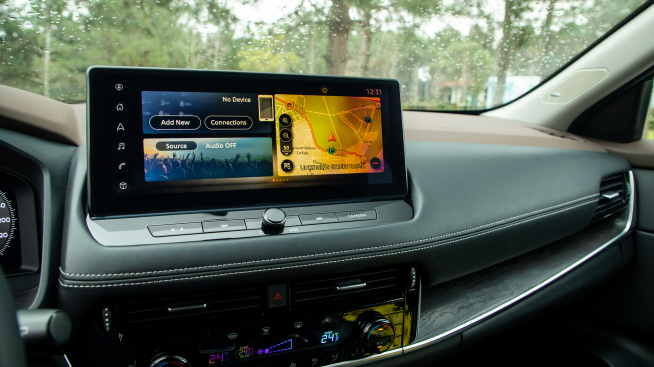SUV vs. sedan: A buyer’s guide

Sport utility vehicles (SUVs) and sedans are two vehicle types that potential new car owners often debate between as they narrow down their options — and for good reason. The motor matchup of SUVs vs. sedans is a tough competition, one where there may be no real knock-out, winner-takes-all victor. In reality, the car you crown as your personal champion may be easier to determine by comparing the pros and cons of each and choosing the one that best serves your day-to-day needs.
Sedans vs. SUVs
Sedans and SUVs are two tried-and-true vehicle body types seen coast-to-coast. If you’ve ever driven before, there’s a strong chance you’ve already gotten behind the wheel of a sedan or SUV at some point. While modern sedans and SUVs often share the latest technological features, there are core differences between the two that could be useful to understand when deciding what kind of car you should buy.
What is a sedan?
A sedan is typically a two- or four-door, fixed-roof vehicle featuring a “three-box” design that separates the engine (typically a V4 or V6), cabin and trunk into three distinct compartments. Sedans are also typically built lower to the ground and smaller than SUVs, giving them a potentially sleeker appearance and often better fuel efficiency. Their smaller frame typically makes them an ideal choice for urban driving, as they’re usually more adept at weaving through traffic, maneuvering tight corners and squeezing into hidden-gem parking spots.
What is an SUV?
An SUV is a type of passenger vehicle that’s typically built to handle tougher road conditions with an elevated seating position, ground clearance and taller cabin. SUVs are also more likely to include all-or four-wheel drive (AWD or 4WD) capabilities, which may serve a wider range of driving conditions and terrains. This could benefit adventurous buyers looking for their next solo trip vehicle.
SUVs typically have a larger cargo area with trunk access through a flip-up rear hatch door, which may make them a convenient option for families or new parents wondering where they’ll fit all that baby gear. Under the hood, you’ll typically find SUVs to have more powerful engines to accommodate their size and weight. On one hand, this could allow for some towing capacity, but on the other hand, this may also render them less fuel-efficient than sedans.
Compact SUV vs. sedan
Through your research, you may see that SUVs are categorized as either “mid-sized” or “compact.” Compact SUVs may be a happy medium for buyers who are torn between sedans and SUVs. In general, compact SUVs are smaller and lighter than their mid-sized counterparts. This gives them some of the same advantages as sedans, such as improved fuel economy and agility on the road, while also offering SUV-style advantages like a taller ride-height and extra cargo space.
Sedan vs. SUV: Pros and cons
Buying your first vehicle (or any vehicle, at that), may seem like an overwhelming experience, but it doesn’t have to be. Ultimately, it’s about making the choice that best fits your lifestyle, which is where comparing pros and cons and evaluating the differences between sedans and SUVs can come into play. Throughout your cross comparison, think about how each advantage or disadvantage would play into your day-to-day life.
Advantages of sedans
The potential pros of sedans include:
- Budget: Sedans usually offer better fuel economy, and while this may be highly dependent on fluctuating fuel prices, it could end up saving you money in the long run.
- Agility: Sedans are typically lighter than SUVs and may be especially advantageous for urban drivers who value extra maneuverability. Some sedans may even offer AWD or 4WD systems to increase their capabilities across multiple terrains.
- Design: Sedans are sleek, lightweight and may appeal to those looking for a more classic aesthetic on the road.
Disadvantages of sedans
The potential cons of sedans include:
- Close quarters: Sedans typically offer smaller cabin dimensions and seating capabilities than SUVS. This could pose a problem if you have a growing family who might need more seating available.
- Limited towing capability: While some sedans may be able to pull a small boat or trailer, most sedans come with very limited towing capacity.
- Less storage space: Sedans will usually offer less storage space and smaller cargo capacity than SUVs.
Advantages of SUVs
The potential pros of SUVs include:
- Space: On average, SUVs provide more space to accommodate more people and cargo. This could be especially helpful for larger families or adventurers who need to stow away some extra gear.
- Off-road performance: SUVs typically come with AWD or 4WD systems, which gives them the potential for enhanced performance across multiple terrains.
- Better visibility: The higher seating position of SUVs may allow you to get a better view of the world around you on the road.
Cons of SUVs
The potential cons of SUVs include:
- Economics: With their heavier weight and stronger engines, SUVs may end up burning through fuel quicker than sedans. This could potentially result in a higher total cost of car ownership over the long run.
- Bulkier drive: SUVs may not be as streamlined as sedans and are typically heavier. This could result in a “stockier” feeling when they’re driven and limit their ability to maneuver around tight spaces. If that’s a potential concern, it may be something to look out for during your next test drive.
- Design: SUVs have an unmistakably larger profile compared to sedans and might not be the first choice for drivers looking to buy a vehicle with a sportier aesthetic.
Are SUVs safer than sedans?
Being lower to the ground, sedans have a lower center of gravity which helps make them more stable and maneuverable on the road. Some may say this leads to a safer driving experience. However — all other things equal — larger, heavier SUVs may provide better crash protection, giving SUVs a slight driving safety advantage. However, when considering the sophistication of advanced modern safety features, the difference may be less significant a factor overall.
What are advanced driver assistance systems (ADAS)?
Modern SUVs and sedans typically come with various advanced driver assistance systems (ADAS) that are designed to improve driving safety and convenience — these systems work by assisting drivers as they operate their vehicles. ADAS systems work by monitoring the environment around your car to provide real-time information and alerts, helping you to avoid collisions and other potential hazards. Examples of ADAS features you may have encountered include lane departure warnings, adaptive cruise control and corrective steering.
Check for safety ratings
When you’re comparing sedans to SUVs, it may be helpful to check the safety ratings of various makes and models. The Insurance Institute for Highway Safety (IIHS) and National Highway Traffic Safety Administration (NHTSA) conduct crash tests and provide safety ratings through a standardized system for a wide range of vehicles on the road. This may be a way to reliably educate yourself on the comparable safety between various vehicles.
In summary
As you see, the battle of SUVs vs. sedans is a true judges’ decision. Whether it’s the spacious all-terrain ability showcased by the SUV, or the compact design and agility of sedans, the best choice for you is ultimately a decision only you can make. It helps to take some time to consider your lifestyle and carefully evaluate which vehicle best fits your needs before declaring a winner.



